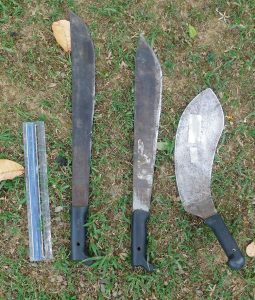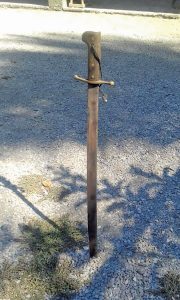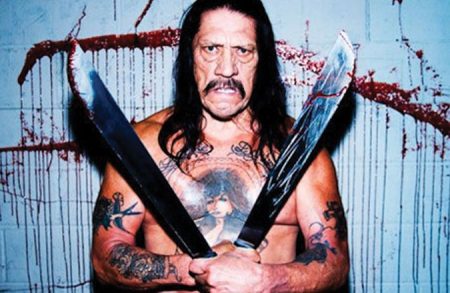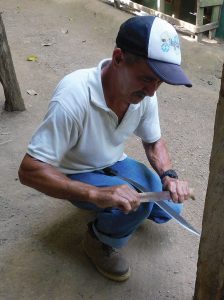Machete
 Many years ago on a Saturday afternoon, having gone to the police station in Matapalo for something or other, I found a hand cuffed, bare footed, blood covered man with a deep cut starting on his right shoulder and extending across his chest. There was blood on the floor, the chair he was sitting in, and even on the wall. Don Marcos, the policeman, was sitting at his desk writing up a report. “Machete fight,” he said in reply to my inquisitive look. “The other one’s on his way to the hospital. This one started it,” nodding toward the bloody prisoner.
Many years ago on a Saturday afternoon, having gone to the police station in Matapalo for something or other, I found a hand cuffed, bare footed, blood covered man with a deep cut starting on his right shoulder and extending across his chest. There was blood on the floor, the chair he was sitting in, and even on the wall. Don Marcos, the policeman, was sitting at his desk writing up a report. “Machete fight,” he said in reply to my inquisitive look. “The other one’s on his way to the hospital. This one started it,” nodding toward the bloody prisoner.

To the average outsider visiting rural Costa Rica the big knife is simply a machete, but to the campesino, or rural resident, it is an absolute necessity of life. Machetes are used for everything: chopping weeds, cutting small trees, trimming hedges and bushes, pruning trees, peeling the bark off of poles, splitting kindling, peeling oranges, harvesting rice, corn, cacao, bananas, and other crops, cutting boards, shaving the edge of a board, scraping crud off of anything, unscrewing bolts, cutting lawns, digging in flower beds, killing snakes, and I’m sure there are more that can be added to the list. I have never seen anyone shave with one, but I don’t doubt that it has happened. As mentioned above it is, on rare occasions, used as a weapon. More about that later.
I wouldn’t be surprised if Costa Rican campesinos have as many names for the long bladed knives they use in their daily lives as Eskimos have for snow. Not all campesinos from all locations will agree with these names as they vary from one place to the next.

Macheta – an all purpose machete that is usually carried in a scabbard hung from a belt.
Guapota – a large machete between 24 and 28 inches long that is used to cut down thick secondary growth. It is much wider near the point than the haft.
Cutacha – this is a shorter version of the guapota between 20 and 24 inches long. It is often used in palm plantations to hack through the fibrous leaf stems.
Rula – a narrow bladed machete, 26 to 28 inches long, that is used to chop weeds in pastures. It is very efficient for cutting non woody stems.
Machete pala or machete de suelo – a short, very wide-bladed machete used to cut lawns and as a trowel in gardening. It works great for putting a nice edge on a lawn.
Machete curvo – a medium size machete that is curved or doubled over at a 45º angle in the middle. The part near the haft is narrow and the part after the bend is wide. It is used like a scythe to harvest rice, corn, and other grains.
Cruzeta – a long narrow machete similar to a sword, that years ago men wore for a night on the town. The blade is narrow and is distinguished by a cross piece separating the blade from the haft. The idea is that in a barroom fight the cross piece will protect the wielder’s hand from an opponent’s blade.
Campesinos carry a special file called a lima in a scabbard. It is a flat metal file about a foot long with one edge ground to the sharpness of a knife. The machete is bent with the knee, and the sharp side of the bent blade is then scraped with the sharp edge of the file in order to sharpen it. With my own machete I just use the file like I would on a shovel, and it works fine, but everybody tells me that I’m doing it wrong. I must admit that my worker’s machetes are sharper and hold an edge longer than mine.

Machetes became quite popular after the release of the first of a series of films starring a mean looking character named “Machete” who is played by Danny Trejo. As you might suspect his favorite weapon is the machete, and from the scars on his face, most of which I suspect are the creations of make-up artists, you might imagine that he has been in more than a few skirmishes. The machetes he is holding in the photo are guapotas.
Back in the days when the Osa Peninsula was so wild the police wouldn’t even go there, my good friend Patrick made his living walking over the entirety of what is now Corcovado National Park buying gold. Pat’s mother-in-law owned a pulpería or general store where they also served liquor. After a few too many drinks hot headed miners were often inclined to fight each other with any weapon at hand, and machetes were usually close at hand. “There are three kinds of machete fights,” says Pat, “the first is when both men have machetes, the second when one has a machete and the other doesn’t, and the third when one has a machete and the other a gun. The first type never happen. Both fighters know that even if they win they’re going to get cut, and neither wants that. All it takes to defuse the situation is for someone to talk them out of it. I’ve prevented lots of bloodshed just by talking to the fighters” Pat goes on to say that in the second and third types of machete fights, the fight always takes place and the disadvantaged fighter always ends up dead.

Many of the men who work at Hacienda Barú were practically born with a machete in their hands. When asked if any of them had ever witnessed a machete fight only Juan Ramón said he had. “It was more like a dance than a fight,” he laughed. Juan went on to say that the two hot heads had left the bar called “Rancho Memo” and moved on to the Dominical soccer field to fight. They circled each other, never getting within range of the other’s knife, and occasionally making a jab. Once the fighters saw the local policeman arriving on the scene, both ran away before he could arrest them. This was a type one fight, and, just like Pat said, neither fighter wanted to get cut.
I only know of one machete fight in this area where one of the participants died. In the 1940’s Santana Jiménez, his brother Sen, and a couple of workers were driving a bunch of fat cattle to a barge in Dominicalito to be shipped to market in Puntarenas. They stopped at a cantina along the way and had a bite to eat and a couple of drinks. Sen and the workers went outside while Santana paid the bill. There were a couple of shady looking characters in the cantina who spoke with a Nicaraguan accent. As Santana was on his way out the door one of them made a vulgar remark about his daughter. Santana took offense and in the fight that ensued was hit straight across the forehead with a machete. The blade penetrated his skull and embedded part of Santana’s straw hat in the wound. He received another deep cut on his waist. Someone called out to Sen who quickly returned and took up the fight, severely cutting one of the assailants and chasing them both off. A few days later word got back that the two Nicaraguans had fled as far as Parrita where the wounded one died. Santana’s wound became infected, and he died a couple of weeks later.
For many years at Hacienda Barú we have combated trespassing and illegal hunting by capturing the hunter’s dogs and taking them to the police or wildlife authorities. In the mid-1970s my workers captured three hunting dogs and took them to the road where I could pick them up in my jeep. About the time I arrived so did the hunters. One of them was furious, yelling and screaming and waving his machete around like a mad man. He said that if I didn’t give his dogs back he was going to cut my head off. I didn’t have a machete and the situation was beginning to look like a type two machete fight. Backing away from him I maneuvered myself alongside the jeep, until I could reach in and grab my revolver from the glove box. Seeing that the situation had changed, and we were now in a type three fight, the enraged hunter turned, threw his machete off to the side of the road, and stood there shouting obscenities at me. His brothers ran up, grabbed him, and took him away. I took the dogs to the policeman in Matapalo. That was as close as I have ever been to being in a machete fight, and I never want to be any closer.


My family in Manuel Antonio are from Matapalo area. My suegra’s father went to prison in the 60’s for killing someone with a Rula. ….I saw a fight in LA Cruz where the 2 guys had machetes and the lose got his arm cut OFF . The people and Cops were watching and the locals were screaming , Sangre and Mate Lo .